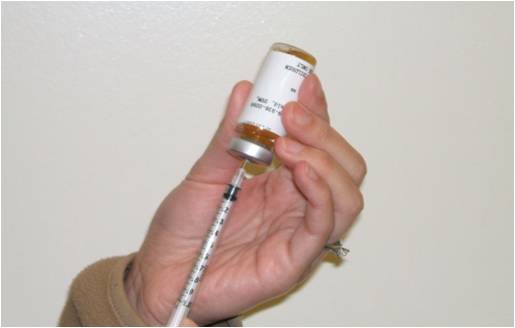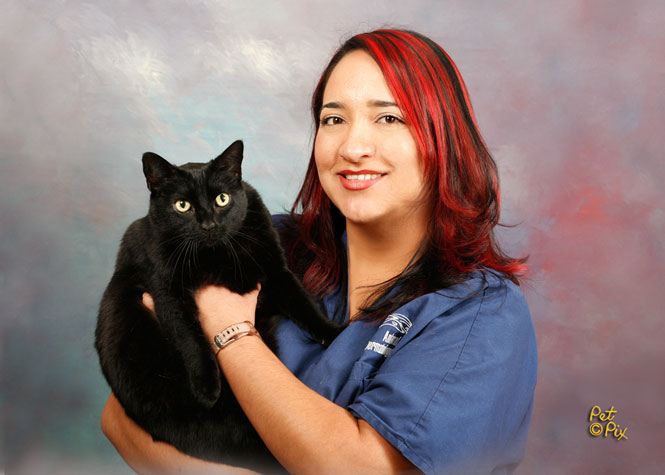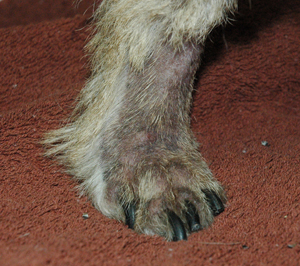New Doctor Joins Louisville Clinic
Joya Griffin, DVM, DACVD
 Joya Griffin, DVM, Diplomate ACVD has joined Animal Dermatology Clinic Louisville.
Joya Griffin, DVM, Diplomate ACVD has joined Animal Dermatology Clinic Louisville. Dr. Griffin graduated from Cornell University College of Veterinary Medicine in 2006. While attending Cornell, she was given numerous scholarships including the Dermatology Service Award for her aptitude in clinical dermatology and her research on Malassezia otitis externa. After graduating, she completed an internship at VCA Berwyn and Aurora Animal Hospitals in Chicago, IL. During her internship year, she was awarded the intern Abstract Award for her presentation on Methicillin-Resistant Staphylococcus Aureus. Dr. Griffin returned to Cornell University in 2007 for a residency in Dermatology and served one year as Instructor of Dermatology after her residency. She became a Diplomate of the American College of Veterinary Dermatology this year.
Dr. Griffin will be seeing clients in Louisville and Lexington, KY.
Taking a Shot at Allergy Injections at Home
After a brief demonstration in the clinic most pet owners are able to administer antigen shots at home.Dr. Craig Griffin has written a step-by-step guide "Allergen-specific immunotherapy: 4 easy steps for home administration". Go to www.animaldermatology.com and click on Tips & Information to download and read this article.

Employee Spotlight: Brenda Hernandez
 “I joined ADC in October 2008 after finally finishing college and lots of traveling. After my travels I didn’t know what to do or where to go but a friend told me ADC was opening a clinic in Pasadena and they needed a tech. My employment at ADC has been a very rewarding and exciting chapter in life. I look forward to getting to work (minus the traffic), there is always a great atmosphere in the clinic which makes the work hours enjoyable, and since I’ve been here since we opened, I have a very close connection with our furry friends and their parents. Besides being an animal lover I am very family/friends oriented, so you’ll always find me running around doing all kinds of things with my loved ones: horseback riding, hiking, cooking and recently, biking. I share my home with many different beings, but my favorite individuals are our 3 dogs, cat, parrot and an awesome opossum, Santiago.”
“I joined ADC in October 2008 after finally finishing college and lots of traveling. After my travels I didn’t know what to do or where to go but a friend told me ADC was opening a clinic in Pasadena and they needed a tech. My employment at ADC has been a very rewarding and exciting chapter in life. I look forward to getting to work (minus the traffic), there is always a great atmosphere in the clinic which makes the work hours enjoyable, and since I’ve been here since we opened, I have a very close connection with our furry friends and their parents. Besides being an animal lover I am very family/friends oriented, so you’ll always find me running around doing all kinds of things with my loved ones: horseback riding, hiking, cooking and recently, biking. I share my home with many different beings, but my favorite individuals are our 3 dogs, cat, parrot and an awesome opossum, Santiago.”
Did you know?
 You probably never thought about a cat as being either left- or right-pawed, but over 40 percent are either lefties or righties. That means there’s quite a few out there who are ambidextrous. Luckily for them, they can probably operate the can opener with both paws …
You probably never thought about a cat as being either left- or right-pawed, but over 40 percent are either lefties or righties. That means there’s quite a few out there who are ambidextrous. Luckily for them, they can probably operate the can opener with both paws …Dogs have a sense of smell that is one of the keenest in nature. Humans might smell a pot of stew cooking on the stove, but a dog can distinguish the smells of each individual ingredient, from the beef itself to the potatoes.

 After a three-year residency program, which includes a rigorous program of intensive review, case studies, writing and publishing dermatology articles, the resident doctors sat for a two-day examination held in Raleigh, NC in August.
After a three-year residency program, which includes a rigorous program of intensive review, case studies, writing and publishing dermatology articles, the resident doctors sat for a two-day examination held in Raleigh, NC in August.
 Atopy is caused by allergic reactions in the environment. These substances, called allergens, can include dust particles, molds, plant fibers, plant pollens, animal particles, and other environmental particles. Some of the signs of atopy may include scratching, licking, and rubbing of their feet, face, ears or body. (Picture above: Irritation and itching cause this dog to lick and chew his paw to the point of har loss.)
Atopy is caused by allergic reactions in the environment. These substances, called allergens, can include dust particles, molds, plant fibers, plant pollens, animal particles, and other environmental particles. Some of the signs of atopy may include scratching, licking, and rubbing of their feet, face, ears or body. (Picture above: Irritation and itching cause this dog to lick and chew his paw to the point of har loss.) Once the allergens are identified, hyposensitization (allergy injections) may be a course of action. These are a series of injections of dilute allergens that make the pet less sensitive to its allergies. After a brief demonstration in the clinic, most pet owners then administer these injections at home (See accompanying article). Alternative forms of treatment include: antihistamines, corticosteroids or other immune-modulating therapy. Antihistamines will help some allergic pets but not all will work for every pet and short trial period of various antihistamines may be used to determine the one that offers best relief. Corticosteroids can be used when antihistamines are not completely effective. However, long term use will almost always result in undesirable side effects. In order to minimize side effects, the lowest dose of steroid should be found and utilized only if other forms of therapy have failed.
Once the allergens are identified, hyposensitization (allergy injections) may be a course of action. These are a series of injections of dilute allergens that make the pet less sensitive to its allergies. After a brief demonstration in the clinic, most pet owners then administer these injections at home (See accompanying article). Alternative forms of treatment include: antihistamines, corticosteroids or other immune-modulating therapy. Antihistamines will help some allergic pets but not all will work for every pet and short trial period of various antihistamines may be used to determine the one that offers best relief. Corticosteroids can be used when antihistamines are not completely effective. However, long term use will almost always result in undesirable side effects. In order to minimize side effects, the lowest dose of steroid should be found and utilized only if other forms of therapy have failed.